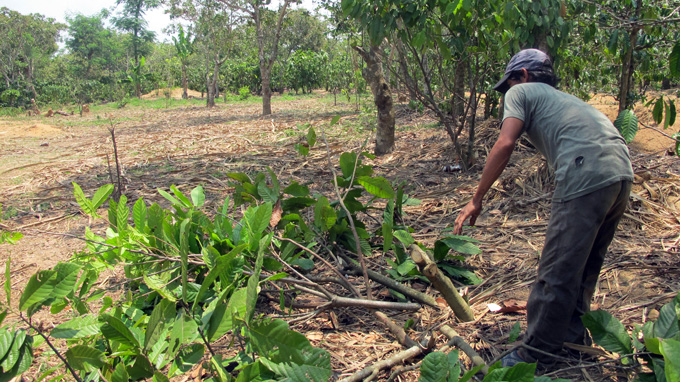A number of farmers in the Central Highlands province of Dak Lak are emptying their cacao plantations to switch back to cassava and sugarcane, crops they destroyed not long ago to make space for the cacao trees, which have since become a nuisance.
The cacao plantations have been grown for three to five years, under projects invested in by foreign companies that have proven incompatible with local conditions.
Maro Y Pac, 44, is cutting down the very last cacao trees in his plantation, in order to start a new cassava crop.
Back in 2007, Pac used to grow cashew, but was encouraged by a foreign project to switch to cacao in the hope of escaping poverty.
“The project gave me 250 cacao seedlings for free and some fertilizer to start with,” Pac recalled.
Farmers joining the project were even more encouraged following news that cacao prices were rising at that time, he said.
What they did not expect is that the cacao trees developed slowly and ended up dying before reaching maturity.
“After five years I was only able to harvest a few dozen kilograms of cacao bean,” he said sadly.
Similarly, Y Thin Bya also received 300 seedlings, none of which are alive today.
“It’s not easy to grow cacao,” he said, adding that he has switched to growing sugarcane, which “requires less production while yielding better income.”
Pac and Bya are among members of a cacao growing project initiated and sponsored by the Adivoca Group in Ea Sar Commune in 2007.
At first, 77 households participated in the project, but one third of them have given up, according to Nguyen Van Sy, chairman of the local People’s Committee.
The crop area also fell from 300 hectares to only 139 hectares, and no farmer has ever posted high profits from cacao, he added.
Incompatible
Farmers taking part in the Adivoca project would receive seedlings and fertilizers to start their crops, but eventually suffered poor production due to their lack of experience, according to Nie Hoang, a local agricultural expert.
A recent study by the Institute for Studies of Society, Economics and Environment (iSEE) also found that the cacao growing in the Central Highlands appears to be unsustainable.
Doctor Nguyen Minh Phong, an iSEE official, said many farmers chose to grow cacao only because they were given free seedlings and fertilizer, while the plant is not suited to be grown in the areas.
The project also failed to conduct adequate research about the local soils, he added.
“Many areas in the Central Highlands have poor water supply but cacao was still planned to be grown there,” he explained.
According to the Vietnam Cacao and Coffee Association (Vicofa), cacao is not interesting to many farmers thanks to its poor economic value and productivity, compared to other plants such as coffee, rubber, or pepper.
“We do not expect much from cacao as its price is instable, and no cases in which farmers have escaped poverty by growing cacao have ever been reported,” Sy, chairman of the Ea Sar Commune, said.




















































